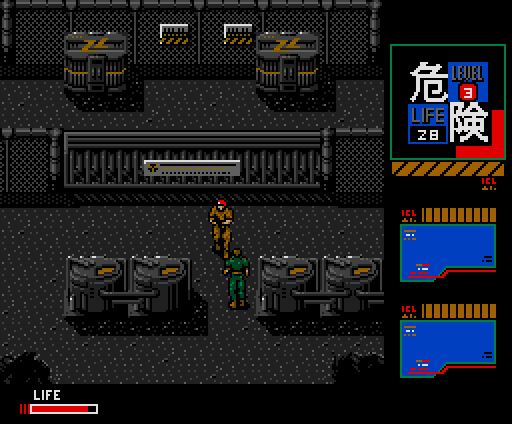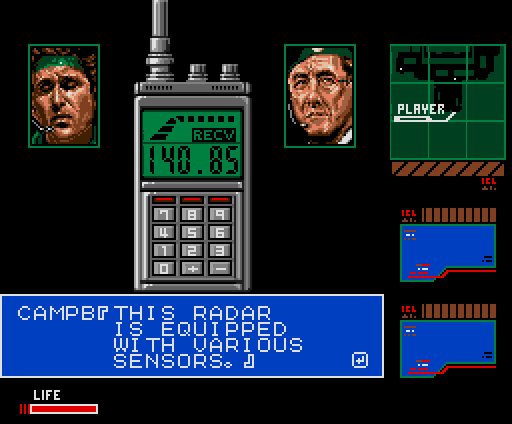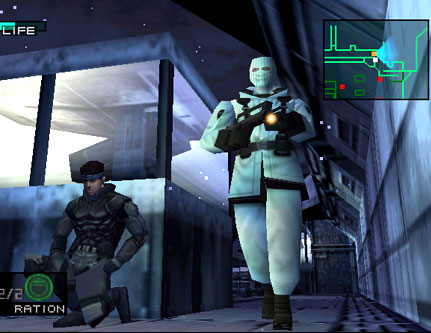This post has not been edited by the GamesBeat staff. Opinions by GamesBeat community writers do not necessarily reflect those of the staff.
Be sure to check out the rest of my Metal Gear retrospective: Part 1 | Part 2 | Part 3
 It’s unfortunate that the first sequel to Metal Gear was not only a continuation of the disappointing NES version, but that it was also Snake’s Revenge. When being nice, Kojima commented that he liked it, and said that it remained “faithful to the Metal Gear concept”. That never stopped him from developing Metal Gear 2: Solid Snake, however.
It’s unfortunate that the first sequel to Metal Gear was not only a continuation of the disappointing NES version, but that it was also Snake’s Revenge. When being nice, Kojima commented that he liked it, and said that it remained “faithful to the Metal Gear concept”. That never stopped him from developing Metal Gear 2: Solid Snake, however.
Available only in Japan for many years, Metal Gear 2 is the true sequel to the MSX2 original. Shamefully, English-speaking players could only enjoy it thanks to a fan translation released twelve or thirteen years after its original release, though a few years after that it was translated and included alongside the original Metal Gear as a bonus in Metal Gear Solid 3: Subsistence’s bonus disc.
I've only completed Metal Gear 2 twice; the first time was with the fan translation, and I recently played through the PS2 version for this retrospective. To be honest, it's the game in the series I know the least about. Whilst its gameplay is very forward thinking, I find it difficult to accept its shortcomings compared to its evolutionary descendent, Metal Gear Solid. And whilst it's objectively better Metal Gear, it's also more complicated than it; I feel that my irrational bias to trivialise 2D gameplay hurts my enjoyment of such a complicated title.
However, Metal Gear 2 is an important game in the series. It set the groundwork for the future of the franchise, and pushed the action/shooting genre forward in ways that were largely ignored for another decade. For that reason, it would be hard for me to ignore it, or to not dedicate a whole article to it, despite my limited knowledge on it.
Taking place four years after the Outer Heaven uprising, Solid Snake is forced out of retirement due to an escalating situation in the rogue nation of Zanzibarland. A Czechoslovakian scientist called Dr Marv — creator of synthetic oil replacement, OILIX — has been kidnapped by Zanzibarland troops, and the rogue nation is planning to control the supply of OILIX to the rest of the oil-starved world, with their major defence being nuclear weapons.

FOXHOUND’s new commander, Roy Campbell, has asked Snake to infiltrate the rogue state and rescue Dr Marv. Helping him along the way will be Holly White, a CIA agent disguised as a reporter; and former Státní bezpečnost agent, Gustava Heffner (known in the original as Natasha Marcova, but later changed in the English release), who was acting as Marv’s bodyguard until his capture.
The game throws players into the action fairly quickly, and introduces new gameplay features almost instantly. Added is the ability to crawl, which is useful not only for moving silently across noisy surfaces, but also for slipping under tables and damaged fences. Another neat feature added to Metal Gear 2 was the radar, which allows players to see activity on the areas directly adjacent to the one they’re in.
However, the first and most striking thing in Metal Gear 2 is the graphics. For a game released in 1990 and on the MSX2, it looks somewhere halfway between a NES and SNES games. The level of detail is closer to the NES than its successor, but the colours are richer and far more varied. Even by MSX2 standards, which the original Metal Gear looked great on, Metal Gear 2 looks spectacular.
Because the front door of the base isn’t open Snake needs to use the vents to infiltrate, and before you enter the main base you can acquire a pistol without ammo. Later on in the game, you can fight a Hind-D helicopter, use your cigarettes to see laser trip beams, use C4 explosives to blow open recently walled up passages and receive secret warnings about minefields and other hazards over the radio from “one of your fans”. Besides that, Metal Gear 2 also introduces the alert status, meaning that once discovered, guards will continually come for you until you find a place to hide and wait for the status to vanish.

Now, all of this will sound strangely familiar to anyone who has played Metal Gear Solid. In fact, it’s quite fair to say that in many respects, Metal Gear Solid is the 3D imagining of Metal Gear 2’s best gameplay mechanics.
The similarities don’t end there. Gustava, like Meryl in the sequel, has to hide as an enemy soldier, and the only way for Snake to identify her is to follow her into the women’s toilets. Just like with Meryl, Snake temporarily teams up with her.
However, many of Metal Gear 2’s oddities didn’t survive the jump to 3D. The first bit of nonsense was having to convince one of the guards that it’s night time, so that for some reason the security will be relaxed enough for Snake to infiltrate a new area. To do this, you have to hatch an owl from an egg, and use its call to trick the guard into thinking that it’s night.
Similarly obscure was having to derive a radio frequency from a tap code. I’m deadly serious. The game has you find out a key character’s frequency by decoding taps, and if you’re not familiar with it you’ll never progress. This key character turns out to be Dr Madnar, the original Metal Gear’s creator. He’s been captured by Zanzibarland and is once again forced to work on a nuclear-equipped Metal Gear, and smaller non-nuclear versions.

Gustava and Snake decide to rescue him in order to reach Marv, and after they find Dr Madnar he reveals to them that Big Boss somehow survived Outer Heaven. He is the man in charge of Zanzibarland, and Snake will have to again face up to his former commander and nemesis.
Madnar informs them of Marv's location, and the three make their way towards him. On the way, Madnar demands a break, and the scene is set for the first real piece of Metal Gear 2’s character development: Gustava tells Snake of a man she almost married, Frank Jaegar (a man who Snake knows as Gray Fox).
Shortly after this revelation, the trio are ambushed on a bridge by Gray Fox himself, who is controlling Metal Gear. He fires a missile at the three, unknowingly killing Gustava and recapturing Dr Madnar. Snake is once again alone, and vows to Fox that he won’t give up his mission. However, before she dies, Gustava hands Snake a key which is used to unlock Dr Marv’s secret OILIX formula (hidden in an MSX2 cartridge, funnily enough).
From here on, Metal Gear 2’s plot is full of the usual twists and turns you’d expect from a Metal Gear game. For starters, when Snake finally catches up with Dr Madnar, you find the other scientist, Dr Marv, dead. Apparently he was unable to withstand the torture.

However, once Snake uses Gustava’s key to obtain the formula, Dr Madnar turns on him, saying he volunteered to work on Metal Gear because he was shunned by the international scientific community after Outer Heaven, and then tries to kill Snake to obtain the formula. To do this, he latches himself onto Snake’s back and slowly drains his health. The only way to beat him is to use remote controlled missiles on your back to get him off.
It’s not exactly the most exciting boss battle, but the fact that he set up Gustava’s death and in turn killed Dr Marv (and despite the fact that Snake saved his and his daughter’s life in the previous game) really adds some punch to his betrayal.
Though that said, for a game which had such a rich plot for the time, it’s easy to look over most of Metal Gear 2’s villains, and understandably so. They’re better than the poor excuses for bosses in Snake’s Revenge, but really feel like they’re only there to act as filler.
Some of their names were references to popular films and literature, such as Black Color (a mistranslation of Blackcollar, changed to Black Ninja in the English release), who was revealed to be Outer Heaven resistance leader Schneider; Running Man; Ultra Box (later renamed The Four Horsemen for the English release); and Predator (Jungle Evil in English).

Besides their unimaginative names and personalities, they’re not that difficult compared to Metal Gear’s (or Snake’s Revenge’s) bosses. Black Color simply moved around the room, haphazardly spraying bullets, whilst Predator’s fight involved stalking him via the radar and avoiding his gunshots when he popped his head up from the tall grass.
But that’s not to say all of Metal Gear 2’s bosses were disappointing. At least this time around you got to fight a fully operational Metal Gear, as opposed to using an obscure combination of C4 detonations to blow up its legs. After that, a very tough hand-to-hand battle with Gray Fox on a minefield leads to his death. Just before he dies, Snake tells him (as emotionally as translated text and 2D sprites can be) that Gustava will be waiting for him.
After this, Snake has to proceed towards Big Boss, where he has to have another showdown with his old mentor. Snake tells him he’s back fighting to keep the nightmares away (PTSD is a condition which Snake continually suffers from throughout the whole series), and then Big Boss explains that the nightmares never truly go away, and that all he thirsts is war and killing.
This battle with Big Boss is one of the most exciting fights in Metal Gear history, despite lacking the cinematic presence of the later games. It involves you running away from Big Boss, completely defenceless, and using a series of key card discoveries to unlock various rooms around the battlefield. In these rooms are other key cards, rations and the tools necessary to create a makeshift flame-thrower: aerosol spray and a lighter.

With only a peashooter compared to Snake’s medium ranged and hard-to-avoid flame-thrower, Big Boss quickly succumbs and screams Snake’s name as he’s slowly consumed by the flames.
Following this, Snake and CIA operative Holly escape from Zanzibarland, being chased down by enemy soldiers and holding off until rescue can arrive. Just as Snake runs out of ammo the chopper guns down the remaining attackers, and the pair escape in one piece with the OILIX formula.
In the end, looking back on Metal Gear 2, it’s hard to not compare it to Metal Gear Solid, a game which brought the gameplay formula into 3D and did away with some of the stupid ideas, such as the tap code and the owl. In that respect, it's quite disappointing simply because it isn't as good. However, despite having first played it nearly thirteen years after its initial release, I couldn’t help but notice how much it influenced Metal Gear Solid many years later, and that's where Metal Gear 2's value lies.
The implementation isn’t perfect, and some aspects are just plain stupid, but Metal Gear 2 is a hugely ambitious game worthy of the series. For some, it’s actually the best, and whilst I’m not one of those people, I can understand why they feel that way.
As far as action games from the 90s go, Metal Gear was pushing narrative in a way that nobody else dared to do. Well, until 1998 anyhow, when Metal Gear Solid was released on the PlayStation. However, if it wasn’t for Metal Gear 2: Solid Snake laying the gameplay foundations that made Metal Gear Solid so successful, the series could’ve developed very differently from the one we have now.
For anyone serious about playing the entire Metal Gear series, Metal Gear 2 can’t be missed. As a game made in 1990 it looks great, and whilst comparing its gameplay to 1998’s Metal Gear Solid can’t be avoided, it only shows how forward thinking Hideo Kojima was when creating it.
Coming next time…

Part 5: Metal Gear Solid on the PlayStation and PC
Further Reading
Metal Gear 2: Solid Snake at The Snake Soup – Probably the best dedicated MGS fansite out there.
Metal Gear 2: Solid Snake at Junker HQ – A superb fansite dedicated to the works of Hideo Kojima.
Chris apologises for the rather generic screenshots used this time. Since he played the PS2 version of Metal Gear 2 for this retrospective, he had no way of lifting screenshots specifically for the article. You can find him on Twitter or his personal site.
